July 27, 2018
Air Date: July 27, 2018
FULL SHOW
SEGMENTS
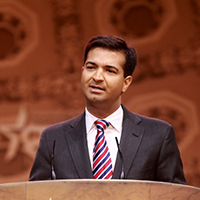
GOP Tax On Global Warming Gases
View the page for this story
On July 23rd, Republican Congressman Carlos Curbelo of Florida introduced the Market Choice Act, a carbon tax proposal to help fight climate change with a “tax swap.” The bill would exchange the gasoline tax for a $24 tax per ton of CO2 or equivalent amount of greenhouse gas emitted, which would increase over time. Former South Carolina Representative Bob Inglis is a Republican who was unseated after he introduced a carbon tax proposal of his own 10 years ago. Congressman Inglis spoke with Host Bobby Bascomb about how his fellow conservatives are responding to Rep. Curbelo’s bill and the infrastructure and climate adaptation strategies that the tax could help fund. (10:28)

What The Osprey Overheard: Mark Seth Lender
/ Mark Seth LenderView the page for this story
As new osprey parents feed and care for their young, even the faintest of sounds – like a distant plane – seem a threat to the youngsters. Living on Earth’s Resident Explorer Mark Seth Lender watches as the ospreys keep a watchful eye, and ear, on their surroundings, and muses on how noisy the human world must be to them. (03:17)

LED Impacts On Wildlife
View the page for this story
LED lights come in different color temperatures, and they can have adverse effects on wildlife, from sea turtles to flies. Research led by Travis Longcore of the University of Southern California helped create the first publicly available database to guide more wildlife-friendly lighting. Travis Longcore speaks with Living on Earth's Steve Curwood about why LED lights could be harmful to human health, too, and ways to more safely illuminate our world. (07:32)
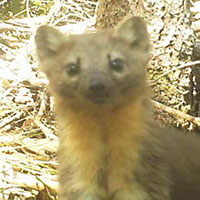
Meet the Rare, Shy, and Hungry Humboldt Marten
/ Jenni DoeringView the page for this story
Deep in the coastal forests of California and Oregon, the Humboldt marten hunts for its next meal. This small but voracious predator is threatened by habitat loss, trapping and the boom of illegal cannabis farming. There are fewer than 400 left in the wild, and California’s Department of Fish and Wildlife is seeking to designate the Humboldt marten an endangered species. Senior Scientist Tierra Curry at the Center for Biological Diversity speaks with Living on Earth’s Jenni Doering about the long battle to get this charismatic creature protection. (08:58)
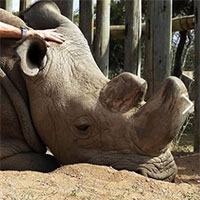
Science Note: A Moonshot To Save Rhinos
/ Don LymanView the page for this story
The last male Northern White Rhino recently died, leaving the species on the verge of extinction. But researchers have decided to try and preserve the species by injecting preserved sperm of the Northern White Rhino into the eggs of a close subspecies: the Southern White Rhino. Living on Earth’s Don Lyman reports. (01:54)
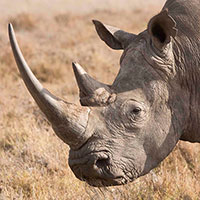
DNA Technology For Rhino Protection
View the page for this story
With rhinos on the verge of extinction, conservationists are turning to novel efforts to prevent poaching. Living on Earth’s Bobby Bascomb reports on how a DNA database in South Africa is helping law enforcement agents identify the origins of seized rhino horn in order to deter poaching. (05:44)

US Tries To Boost Infant Formula
View the page for this story
Breastfeeding came under fire at the World Health Assembly meeting in Geneva this past spring. The United States delegation mounted an opposition to proposed breastfeeding regulations that would encourage nations to limit the use of infant formulas and milk substitutes. Director of the Infant Feeding Action Coalition in Canada, Elisabeth Sterken, talks with Host Bobby Bascomb about the benefits of breastfeeding and the risks of aggressive infant formula marketing. (08:33)
Show Credits and Funders
Show Transcript
HOST: Bobby Bascomb
GUESTS: Tierra Curry, Bob Inglis, Travis Longcore, Elisabeth Sterken
REPORTERS: Jenni Doering, Mark Seth Lender, Don Lyman
[THEME]
BASCOMB: From Public Radio International – this is Living on Earth.
[THEME]
BASCOMB: I’m Bobby Bascomb, in for Steve Curwood.
A republican congressman recently introduced the Market Choice Act, a bill to put a price on carbon dioxide emissions.
INGLIS: Those of us who are conservative say that what needs to happen is that there needs to be a price signal rather than a regulatory answer to climate change. And so what the bill does is says if by 2025 this price signal isn't working, then the EPA can regulate greenhouse gases, but until then, give a price signal a chance.
BASCOMB: Also, getting endangered species status for the reclusive Humboldt marten.
CURRY: It’s this super secretive forest creature that doesn’t want to be seen by anything but wants to eat everything that walks by. And from a scientific standpoint, they are just adorable.
BASCOMB: Those stories and more this week on Living on Earth – Stick Around!
[NEWSBREAK MUSIC: Boards Of Canada “Zoetrope” from “In A Beautiful Place Out In The Country” (Warp Records 2000)]
[THEME]
GOP Tax On Global Warming Gases
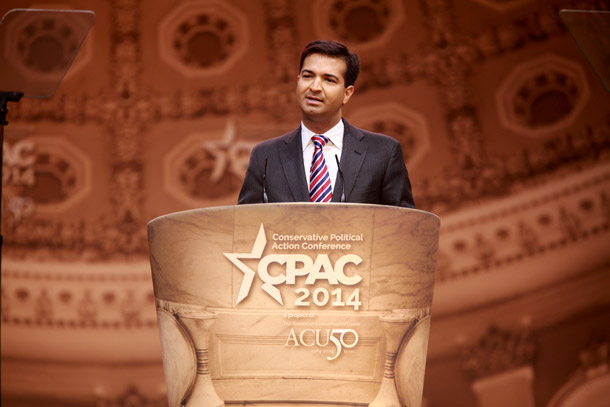
Representative Carlos Curbelo’s (R-FL) Market Choice Act is a carbon tax that would replace the federal gas tax and generate revenue for infrastructure. (Photo: Gage Skidmore, Flickr CC BY-SA 2.0)
BASCOMB: From PRI and the Jennifer and Ted Stanley Studios at the University of Massachusetts Boston, this is Living on Earth. I’m Bobby Bascomb.
For the first time in a decade a Republican member of Congress has introduced legislation to address carbon dioxide emissions. Representative Carlos Curbelo of Florida introduced a bill called the Market Choice Act. It would impose a tax of $24 dollars per ton on greenhouse gas emissions from oil refineries, coal mines, and natural gas processing plants. The tax will increase by 2 percent annually plus inflation. Representative Curbelo unveiled his plan at the National Press Club.
CURBELO: At this time of deep political division and, at least some days, political chaos, I am offering this big, sober solution to address some of our country’s greatest challenges.
BASCOMB: Estimates suggest the carbon tax will raise one trillion dollars over the next decade with the bulk of that money going towards infrastructure improvements, something both Republicans and Democrats have said they support. Representative Curbelo acknowledged that a carbon tax might be a tough sell for some of his GOP colleagues, but he says it beats the alternative.
CURBELO: I remind my conservative colleagues who often decry our nation’s growing debt: saddling young Americans with a crushing environmental debt – meaning an unhealthy planet where life is less viable – is at least as immoral as leaving behind an unsustainable fiscal debt. Already my constituents in South Florida are experiencing the effects of higher sea levels with chronic coastal flooding and salt water intrusion in the Everglades, which threatens our drinking water supply.
BASCOMB: For more on the carbon tax proposal we turn now to former House Representative Bob Inglis. He’s the director of the free-market environmental organization, RepublicEn.
Welcome back to Living on Earth!
INGLIS: Great to be with you. Thanks.
BASCOMB: So, what would the Market Choice actually do in terms of net carbon dioxide emissions? What are the estimates right now?
INGLIS: Dramatic reduction sufficient to meet – or exceed actually – our Paris commitments, and so it's pretty exciting really. According to a Columbia University study, as this tax increases, it’d be at $50 dollars per ton – it would slash emissions by 39 percent by 2030.
BASCOMB: So, what other regulations or laws might be changed or replaced if Mr. Curbelo's proposal is adopted?
INGLIS: Representive Curbelo has a very creative idea. It's basically to give a price signal a chance. Those of us who are conservative say that what needs to happen is there needs to be a price signal rather than regulatory answer to climate change, and so what the bill does is if by 2025 this price signal isn't working, then the EPA can regulate greenhouse gases. But until then, give a price signal a chance.
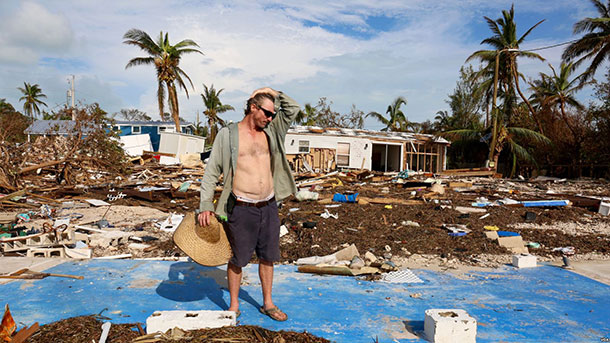
South Florida is already feeling the effects of climate change. In 2017, the area was hit by Hurricane Irma, which devastated homes in areas including the Florida Keys. (Photo: Voice of America (VOA), Wikimedia commons, public domain)
BASCOMB: So, oil companies, coal mines, things like that, they're going to start paying more to produce their product and find better ways to produce it. That's basically the idea?
INGLIS: That's right. This would be an upstream application of the tax. That means that it's a very simple job for the IRS. There are only about 2,000 companies in America that either mine coal or put stuff in a pipeline, and so, very simple job for the IRS and simple for us as consumers. We do see the price go up to the true cost of energy. It's not going up artificially, it's going up to the truer cost, and once we see that it behooves us to turn the thermostat down or to insulate better or to get an electric car, do something like that.
BASCOMB: Well, how much money will be generated by the carbon tax, and how will it be spent? I understand infrastructure is a large part of it.
INGLIS: Yeah, it's going to generate a great deal of money. We're looking at nearly a trillion dollars. Seventy percent of it would go to the highway trust fund, and so this is a good thing if you're interested in infrastructure, which is really a key point about the Curbelo bill is that it's a very innovative creative way of dealing with several problems all at once. There seems to be an appetite in the country for infrastructure improvements – roads, bridges, airports – but there's no money for it. So, it also funds some adaptations that are necessary in places like Carlos Curbelos' Miami, which are dealing with climate change and need to put up some sea walls and install some pumps.
BASCOMB: Well, how have the various stakeholders responded to the proposed tax? I'm thinking specifically of oil and gas companies and environmental groups.
INGLIS: Thankfully, the Nature Conservancy is full-throatedly endorsed the bill, and that's pretty exciting. That's a very credible group that cares about the environment we live in. As to oil companies, it depends on your portfolio. If you are in the Petroleum Marketing Association of America and all you've got to sell is petroleum, you're probably really opposed to this bill because you really don't want a carbon tax. But if you're ExxonMobil and you've got a large portfolio of natural gas, then a $24 dollar per ton price on carbon dioxide would result in you selling a lot more natural gas and beating coal better than you're beating it now for electrical generation. And so, where you sit determines where you stand in politics and in business. What your portfolio looks like determines where you stand.
BASCOMB: Now, what about where Republicans are sitting? Most Republicans seem to have a knee-jerk reaction when they hear the word "tax" and just say no.
INGLIS: Yes, so far that has been the reaction. What we're trying to convince conservatives of at republicEn.org is that it's a tax swap we're talking about here in a bill like Carlos Curbelo's or in other proposals like from Citizens’ Climate Lobby. These are bills where we're swapping the taxes. Yes, we're putting in a new tax called a carbon tax, but we’re – in Carlos' case – eliminating the gas tax, and in the Citizens’ Climate Lobby case you would be returning the money in the form of a dividend. So, these proposals are not like the villain of a carbon tax that some Republicans have been seeing under the bed at night. I think it's because there's been some gremlins around from various groups that see no way to innovate in their business, and so they're making all kinds of scary noises that are being emitted from underneath the bed. But if we turn on the lights, what we'd see is a revenue-neutral border-adjustable carbon tax. That means – revenue neutral means you cut taxes somewhere else or you dividend the money back or you eliminate the gas tax. And border adjustable means you apply it to imports so that you get China and rest of the world in on the deal.
BASCOMB: Well, just a few days before Representative Curbelo unveiled his plan, 222 of his GOP colleagues voted in favor of a resolution that said any kind of tax on carbon would be detrimental to the United States economy, and only six Republicans voted against that resolution. So, what are the odds, do you think, that Representative Curbelo's proposal will get any Republican support?
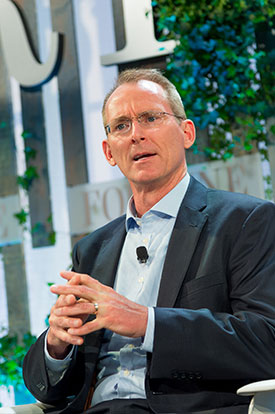
Former Representative Bob Inglis(R-SC) is now the Executive Director of the Energy and Enterprise Initiative, a free market environmental organization. (Photo: Fortune Conferences, Flickr, CC BY-NC-ND 2.0)
INGLIS: Yes, so the Scalise resolution is that focus on the ‘gremlins under the bed’ kind of situation. It was a resolution where Steve Scalise said oh, there is this is terrible villainous carbon tax lurking out there that would increase the size of government that would destroy American competitiveness. Well, given that description, if I were still in Congress, I might have voted for it myself, and then gone on to explain that, but here's the real carbon tax that people are talking about, it’s a tax swap. So, six Republicans in the Climate Solutions Caucus chose to vote against the Scalise resolution, I think to call it out as silly. So, now they've got to explain to some constituents why it is that they wouldn’t have tried to stop that villain of a carbon tax, but that villain doesn't exist, is what their explanation will be. The really – the more complicated explanation, I think, is the Republicans who are members of the Climate Solutions Caucus who voted with Steve Scalise and who have yet to take action on climate change. It means that you've got to come forward with some solutions. If you don't like the carbon tax as Steve Scalise described it – and frankly who would – then come forward with one that is acceptable.
BASCOMB: So, at the end of the day here, what are the odds, do you think, that the Market Choice Act might actually get some traction and go anywhere in this highly partisan Congress that we have right now?
INGLIS: It's still early. I wouldn't expect action in this Congress. I think it's going to take a while, but the great thing is that Carlos Curbelo is a young smart conservative, and if you're young and smart and conservative, you're for action on climate change. And if you're Carlos Curbelo and you represent Miami – which has a problem with sea level rise – has come forward with an idea. And so that's where the process starts and I think we're really more at the starting line than at the finish line, but we're very excited about the starts. It’s the first time in about a decade that a Republican has introduced a proposal to deal with climate change.
BASCOMB: And the last time a Republican introduced a proposal to deal with climate change was you about a decade ago.
INGLIS: Well, yeah, let’s not mention that. That didn't go too well, but that was in the midst of the Great Recession though, probably not the best time to be talking about a carbon tax even if it is revenue-neutral and border-adjustable. But the economy is much better now. We’ve had more experience with climate change. The capacity of the eco-right, as we call it, to help explain this to constituents in groups like ours at republicEn.org is far greater in 2018 than it was in 2009. And it's also true, I think, that President Trump's intended withdrawal from Paris means that there's a discomfort, an unease about – I mean, we're going to do nothing about climate change, nothing at all? And that unease will actually help advance this conversation because people will be saying, wait a minute now. We want to do something about climate change, and maybe a tax swap like Carlos Curbelo is proposing might just work.
BASCOMB: Bob Inglis is director of the free-market environmental organization, RepublicEn. Thank you so much for joining me.
INGLIS: Great to be with you. Thanks.
Related links:
- Columbia University Center on Global Energy Policy Analysis of the ‘Market Choice Act’ carbon tax bill filed July 23, 2018 by Rep. Carlos Curbelo (R-FL)
- Niskanen Center Analysis of the ‘Market Choice Act’ carbon tax bill filed July 23, 2018 by Rep. Carlos Curbelo (R-FL)
- E&E News | “Curbelo rolls out carbon tax plan to deep skepticism”
- The Nature Conservancy | “Statement from the Nature Conservancy on the Market Choice Act introduced by Rep. Carlos Curbelo in the US House of Representatives”
- Bob Inglis’ group, RepublicEn
- Check out LOE’s interview with Rep. Carlos Curbelo
[MUSIC: “Spiderman” soundtrack, “Academic Decommitment”]
What The Osprey Overheard: Mark Seth Lender
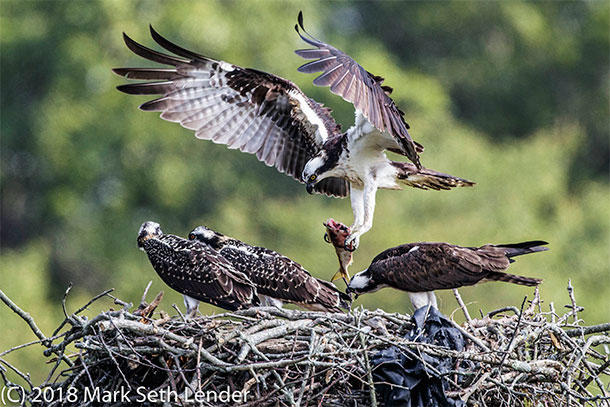
No drones needed for this delivery. (Photo: Mark Seth Lender)
BASCOMB: Osprey have made a remarkable comeback in the last 50 years. But it’s not all smooth sailing – or fishing. Warming waters and massive overfishing by humans alter fish stocks – global events that osprey will have to deal with. But that’s not all. As Mark Seth Lender, Living on Earth’s Explorer-in-Residence, can testify, there is another pressing issue in the air…
LENDER: The marsh goes as far as the river, breaks there, then continues North spreading in all directions for more than two miles, bordered by woods that are dotted with houses. Before the river is an osprey nest that has been there for years, weathered and leaning now. And to the South towards the sea, the storm-slashed remains of sand dunes. The waves run up to the dunes like someone talking in a low voice, muttering to themselves, the one-sided conversation lost on the wind.
An osprey arrives carrying a sanddab. High up he dips and calls announcing his prowess, fisherman and provider. Then lands somewhere out of sight. Now he comes to the nest. The head of the sanddab is already gone, which should be enough, but he cannot part with the rest and leaves his mate without sharing. And comes back. And leaves again. The female sitting on her eggs, blotchy markings like oversized age spots, hardly reacts. She is used to this. He just cannot make up his mind…

An osprey scores a catch. (Photo: Mark Seth Lender)
Two months later, and his mind is inevitably made up for him.
All three fledglings have survived. Every few days they have doubled in size and corresponding appetite. It is constant. As if he himself is being torn apart, like the sea robin he just brought them and that they now slowly rip to pieces. Now he must wait on tide, weather, the things that fish think, that are important to them, and determine where they will be. And when. And how long. Nothing is up to him. All he can do is comply. And somewhere in between he himself must eat.
And he is off again, over the merciless sea. He hovers, moves on, hovers again, and again, the water beneath filed to a grainy opacity by an offshore breeze.
Waiting on the nest, the female, inexplicably, begins her alarm call:
Yat tat tut… Yat tat tut-tut…
There is nothing nearby, not below or above her. The complaint grows. Now she is in full throat, loud and nearly continuous.
The fledglings move about in the nest.
Still nothing…
There. There it is.
A small plane high above the river.
Long before it appeared she heard it. After it vanishes from sight she will still hear it still. How loud this world must be to her, the world we have made all around her.
[MUSIC: “Spiderman” soundtrack, “Academic Decommitment”]
BASCOMB: That’s Mark Seth Lender, Living on Earth’s Explorer in Residence.
Related link:
Mark’s Website
BASCOMB: Just ahead – The endangered Humboldt marten, a charismatic creature that looks like a kitten with the attitude of a honey badger. Keep listening to Living on Earth!
ANNOUNCER: Support for Living on Earth comes from the Gordon and Betty Moore Foundation and from a friend of Sailors for the Sea, working with boaters to restore ocean health.
[MUSIC: “Spiderman” soundtrack, “The Baby Monitor Protocol”]
LED Impacts On Wildlife

LEDs light up our world 24 hours a day, which can harm animals and humans alike. (Photo: David Yu, Flickr, CC BY-NC-ND 2.0)
BASCOMB: It’s Living on Earth, I’m Bobby Bascomb.
By 2020, LED lights are projected to account for 69 percent of the global market – a dramatic increase from 9 percent just 7 years ago. It’s easy to see the benefits: LEDs conserve energy and tend to last longer than the once-standard incandescent bulb.
But when they’re used outdoors, lights – including LEDs – can lead to disastrous consequences for some animals. Travis Longcore is Assistant Professor of Biological Sciences at the University of Southern California. He spoke with Living on Earth’s Steve Curwood.
CURWOOD: So, what made you interested in studying LEDs in the first place?
LONGCORE: Well, the reason LEDs are a major focus of this paper is that they're being used to replace existing outdoor lighting at a rapid pace, and that is changing the nature of the outdoor environment in a way that is not going to be stopped. So LEDs are coming, but we can perhaps guide some of the ways in which they're used, and the choices that are made relative to wildlife – because the color of light matters to wildlife. It also matters to people and the dark sky and circadian rhythms of life on Earth.
CURWOOD: So, Travis, which colors seem to be most harmful for animals, and how did it affect their lives?
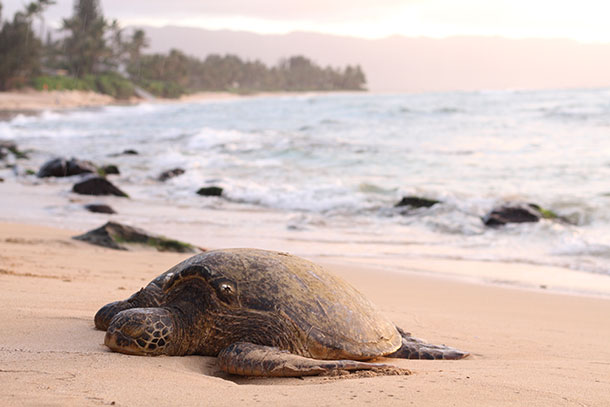
Sea turtles are especially vulnerable to increased light since female turtles only lay their eggs on beaches that are dark, and bright streetlights can falsely direct the hatchlings from the ocean. (Photo: Jeremy Bishop, Unsplash, creative commons)
LONGCORE: The summary of the organisms that we looked at for this study is that lights that have more blue and short wavelengths, blue-violet, are more disruptive to animals. Sometimes they kill them, in the sense of an insect being attracted to a light or a sea turtle, and sometimes it's a behavioral impact that then results in another organism interacting with them in the form of increasing predation. Or in the case of shearwaters, fledglings coming out of the nest attracted to lights on the coast and then don't get out to the ocean where they need to be and end up stranded on the ground, unable to make their way out into the environment where they should be. But it's not that every organism is sensitive to those wavelengths. That's the average over the things that we looked at. There are things that are sensitive to the reds. Flies, for example, seem to have a peak of sensitivity in the reds.
CURWOOD: Talk to me about the animals that you chose to study and why you chose them.
LONGCORE: Yeah, so we use the organisms for which we have some data from other researchers that have been done in the past and concurrently that show the response of the organisms to different wavelengths of light across the whole visual spectrum, from the very short wavelengths in the ultraviolet up through to the yellows and the reds.
CURWOOD: What animals are particularly affected by light in, I guess, positive and negative ways depending on the frequency?
LONGCORE: Well, excluding some things that live in caves where there is never a daily or an annual or a lunar rhythm, every organism is cued into patterns of light and dark. And over the last decade, decade-and-a-half now, we've been as ecologists and conservationists and even people interested just in the night sky have been looking at this question because of the massive transformation that electric lighting represents across the Earth.
CURWOOD: So, how does the light affect a sea turtle, and what's different about a light-emitting diode?
LONGCORE: So, first, female sea turtles only like to lay their eggs on beaches that are dark. So, they'll avoid beaches that are particularly bright. And second, when the hatchlings come out of the nest, they incubate under the sand and they hatch at night. They need to get to the ocean as fast as possible. It's not like they go toward the light – that's a misconception – they go away from the darkest horizon. And when you have artificial lights, if you do have bright street lights or porch lights, they will go toward that and then they get run over by cars and eaten by predators and things like that.
CURWOOD: What's the effect of light and LEDs on juvenile salmon?
LONGCORE: So, salmon can be attracted to lights as they go up or down a stream, and the juveniles coming out, if they're attracted to lights, they're then subject to predation. And there's actually kind of a neat study showing that seals will line up underneath bridge lights and pick off the salmon as they get attracted to the lights. So, it affects the timing and synchronization of their movements and makes them more likely to be exposed to predators.
CURWOOD: So, what are some solutions here?
LONGCORE: We hope that lighting designers, landscape architects, architects, lighting engineers, and decision makers use this information to help inform part of a strategy to minimize the effects of outdoor lighting on things we don't want to affect while providing the benefits for the things that we do.
CURWOOD: Travis, I have to ask you about people as well. How do these LEDs affect us?

Travis Longcore is Assistant Professor of Architecture, Spatial Sciences and Biological Sciences at the University of Southern California. (Photo: Courtesy of University of Southern California, USC)
LONGCORE: We do see that there are epidemiological correlations and experiments that show increases in certain diseases associated with light exposure. There's breast cancer and prostate cancer. There's also relationships of exposure to light at night and sleep disruption to a whole series of adverse consequences, including diabetes and depression.
CURWOOD: So, what effect would watching television at night have on humans, do you think?
LONGCORE: Well, watching television is sort of putting light directly into the eye that tends to have a lot of blue in it. So, it will be stimulating. And this is now been shown with kids who are exposed to e-readers and phones versus exposed to traditional lighting like a candle or a flame – that's a study was done in Japan – their sleep gets delayed. So, yes, watching television and putting the light into your eyes directly, and especially now that we've taken the computer and put it right up in front of our faces.
CURWOOD: See, this is why radio is so important.
LONGCORE: [LAUGHS] That's absolutely right.
CURWOOD: What's your advice for outside lights in this world of now ultra-cheap lighting from LEDs?
LONGCORE: OK, so for outdoor lighting, color temperature is just one of several ways that we can reduce impacts. It's also about directionality, having a shielded light that only goes down where you need the light, using the lowest intensity that you can, and then it's about duration, so using a motion detector instead of a dusk to dawn. And then, of course, always asking the question, do I need this light or is there another solution? So, for example, you could do a pathway between a campground and a parking lot, and instead of lighting it you could have it be white gravel, so that white picks up all the ambient light, and it's very clear where the path is. So instead of adding lights on that pathway you could maybe deal with it in another way that gets the function going without actually disrupting the wildlife and the wild land experience.
CURWOOD: So, at the end of the day then, what you're saying is we're conducting a massive experiment on the whole ecosystem with all this artificial light.
LONGCORE: Yeah, it's a massive public health experiment. And so what we're providing is a set of tools to give to decision makers to make an informed decision on all of these – and not just humans and the ethical treatment of humans but on all life – so that we can make choices that best avoid the things that we know are damaging even if we don't have the last bit of proof for every single thing. We wanted to get this out there now because these changes are happening now, and we should act on the best available science and not wait until we've completed the experiment.
BASCOMB: That’s Travis Longcore from the University of Southern California speaking with Living on Earth’s Steve Curwood
Related links:
- USC News | “Scientist’s new database can help protect wildlife from harmful hues of LED lights”
- Travis Longcore’s Website
[MUSIC: Maria Kalaniemi and Aldargaz, “Triolipolska” on Iho, by Timo Alakotila/arr. Timo Alakotila, Hannibal Music]
Meet the Rare, Shy, and Hungry Humboldt Marten
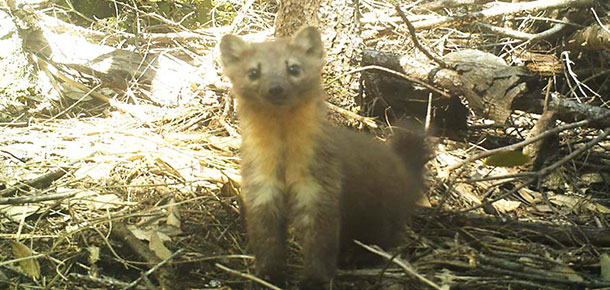
The Humboldt marten is an elusive creature that prefers to slink in the dark corridors of dense old-growth forest along the Pacific coast. (Photo: Mark Linnell, U.S. Forest Service)
BASCOMB: Humboldt martens are furry three-pound predators that live in the underbrush of the dripping-wet coastal forests of California and Oregon. They’re voracious eaters, and almost always on the hunt for snacks: a squirrel, a bird, or lighter fare, like berries, eggs, and insects. But this little member of the weasel family is threatened by habitat loss, old-growth forest logging, and even the recent expansion of cannabis growing operations. There are just 400 Humboldt martens left in the world and California’s Department of Fish and Wildlife says they should be listed as an endangered species. Tierra Curry from the Center for Biological Diversity says the martens deserve that protection. She spoke with Living on Earth's Jenni Doering.
DOERING: So, first, Tierra, how would you describe the Humboldt marten?
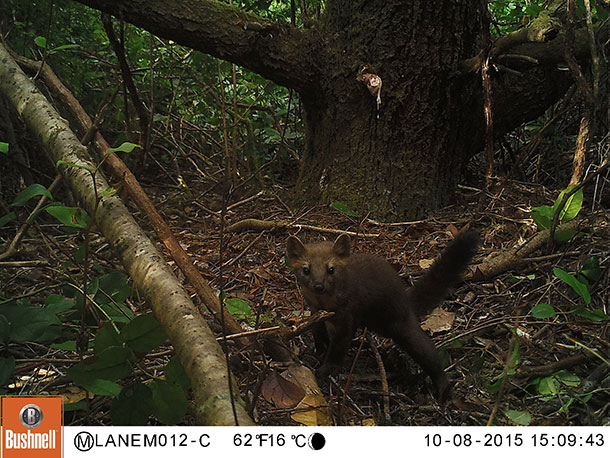
Despite weighing a mere one to three pounds, the Humboldt marten is a voracious eater and a fierce predator. (Photo: Mark Linnell, U.S. Forest Service)
CURRY: Well, it's like a little Tasmanian devil. It's a kitten that thinks it's a honey badger. It's this super secretive forest creature that doesn't want to be seen by anything but wants to eat everything that walks by. And they're adorable. [LAUGHS] From a scientific standpoint, they are just adorable.
DOERING: Have you ever met one?
CURRY: No, and every summer my son and I go out to the Oregon coast and we crawl into the bush and look around and hope to see one. And we've done this for four years now, and we haven't seen one. But I'm hopeful that if we can get them protected and get their habitat improved that he might get to see one someday.
DOERING: What's their behavior like? How would you describe that, Tierra?
CURRY: They're really stealthy and they don't want to cross open areas, which is why they became endangered. Ninety-five percent of their old-growth mature forest habitat has been lost, and that's how they got into this pickle where there's only 400 of them left in four separate populations. There's two populations in Oregon, two populations in California, and they can't get to each other because they don't want to cross open areas. If they venture out into clearcuts across the road, they get hit by cars or they get munched by bobcats or coyotes or other animals that hang out in the clearcuts. So, to save them, we've got to reconnect the four populations.
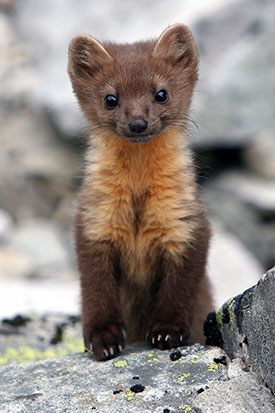
Once thought to be extinct, photos of the elusive Humboldt marten are extremely rare. Pictured here is a pine marten, a close cousin of the Humboldt marten. (Photo: Steve Slocomb, Flickr, CC BY 2.0)
DOERING: Why are there so few of them left in the wild? I mean, some 400, you said. What are their biggest threats?
CURRY: So, historically the biggest threats were logging and over-trapping. Ninety-five percent of their old-growth mature forest habitat has been lost. At the turn of the century they were commonly trapped for their fur. California banned trapping of them in 1946 because they were already concerned about the decreasing numbers. Oregon still hasn't banned trapping of them, so after 95 percent of the forest was logged, after they were over-trapped, then they were just left in these remnant populations. And now the remnant populations face new threats. On the central coast of Oregon, the whole population is west of Highway 101, in the sand dune, shore pine, shrubbery habitats. And they can't successfully cross the road to get to the more mature forest across the road, so they're threatened by population isolation. And then in northern California and southern Oregon, those populations are more threatened by wildfire and by the cultivation of illegal marijuana on public lands. So, these big illegal marijuana farms put out rodenticides to protect their crops, and then wild animals eat the rodenticides, so now those are a threat to martens, fishers, foxes, owls. Lots of wildlife are getting poisoned by them. So there needs to be a stepped-up presence to go get those operations off of federal lands. There needs to be more funding and just more people on the ground to protect our public lands from these illegal operations.
DOERING: You know, going up to northern California and southern Oregon, you just – you feel surrounded by trees. There's a lot of trees. Why aren't those trees enough?
CURRY: Because the specific habitat features that Humboldt martens need only come in mature forest, forest that's around 80 years old, and they need dense shrub understory that's packed with huckleberries and things for them to hide in and eat. And then, as trees age, they get scars and they develop these features and like funny branches and they get holes in them and lots of places – like if you're a kid playing hide-and-seek, that's like the Humboldt marten. It's got to find a hole or a big knot on a tree or a bush to hide under.
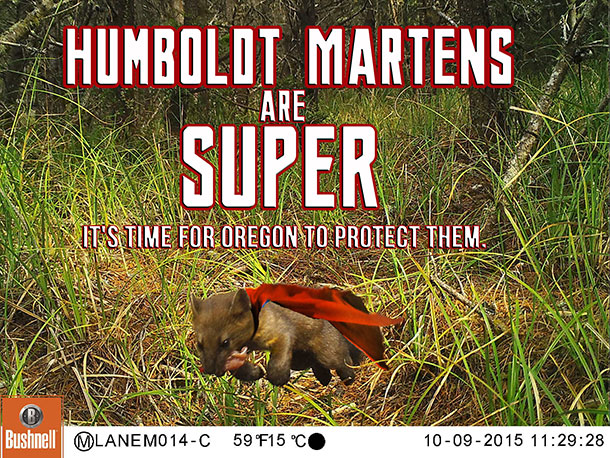
Marten advocates take to the Internet, hoping their memes – combined with the marten’s cuteness – might help spread the word. (Photo: Mark Linnell, U.S. Forest Service)
DOERING: So, if they're so secretive, Tierra, how do we know how many might be out there?
CURRY: So, researchers crawl on their bellies wearing heavy backpacks with cameras and track-plate stations and chicken legs and strawberry jam. [LAUGHS] They're just hungry little buggers. And if you watch the videos of them, they'll see these – it's non-lethal traps that get their footprints and a snag of hair for DNA analysis. And the marten, it'll be all troubled and walk back and forth at the entrance a couple times. And then it just can't resist the strawberry jam and the raw chicken leg, so it dives in and it leaves its tracks, it leaves a DNA sample. There's these remote cameras that snap a picture of it, so that's happened now for the northern California populations and the central Oregon population, and scientists are now studying the southern Oregon population. It's so rare that scientists thought it was extinct until a camera studying other things got a picture of one in the Redwoods in 1996.
DOERING: Gosh, that's amazing. Tierra, what's being done to protect these Humboldt martens?
CURRY: Right now, they don't have any protection at all, and it's so frustrating. I petitioned for Federal Endangered Species Act protection for them with allies back in 2010, eight years ago. The Fish and Wildlife Service made a not-warranted finding, and our jaws dropped. We were like, what do you mean it's not warranted? So, we sued and we won. The judge found that the agency didn't base the decision on the best available science and ordered them to redo it. That decision is going to come down the pipe at the end of September. It will either be a proposed listing, a not-warranted finding, or they'll get put on a waiting list for protection.
DOERING: And how long could they be on a waiting list?

Old-growth forests, like this one in Northern California, serve as both Humboldt marten habitat and an important resource for the timber industry. (Photo: Wikimedia Commons, public domain)
CURRY: Average length of time is 24 years. Forty-two species have gone extinct on the waiting list. But there's an emergency provision if they get put on the waiting list, so if they did that, I would just submit an emergency listing petition for them and say, look, [LAUGHS] the best available science says these guys are in a real pickle and we have to help them. California's going to vote in August whether or not to protect them as endangered, and we just asked the state of Oregon to protect them as endangered. The only protection they have right now is California doesn't allow their trapping.
DOERING: Are there people out there who are concerned about what designating it as an endangered species could mean for local industry?
CURRY: Absolutely. Here in the Pacific Northwest, logging and timber is still a huge hot-button political issue. Any time you say old-growth species, a lot of people kind of freak out and are like, oh no, not another old-growth listing. And so I think the Fish and Wildlife Service is reticent to protect anything else that is associated with old-growth forest because of all the controversy around the northern spotted owl. And I think the agency is just shy, and I think that's why the marten got a negative finding. They shied away from the political controversy. But the thing about the marten is there's so few of them left. In Oregon, they're only found on federal land now because all the private and state land has been logged. And at this point, it is kind of an emergency situation to get them protected, get the population stabilized, and then look at reconnecting habitat corridors.
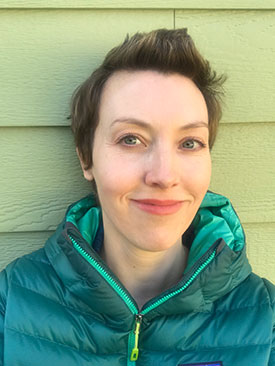
Tierra Curry is a Senior Scientist at the Center For Biological Diversity. (Photo: courtesy of Tierra Curry)
DOERING: What kind of response from the general public have you seen in terms of trying to save the Humboldt marten or give it an endangered species status?
CURRY: I'm getting e-mails from people all around the country who want to know what they can do to help the Humboldt marten, which is pretty touching.
DOERING: What do they say? Why do they care?
CURRY: I think people care because it’s so little and so cute and also because they've never heard of it, and it captures the imagination that there's this secretive animal living in wild forest that we've still never heard of. And it's like a fairytale character of the deep forest that represents the wild, and people are passionate about the wild and about wild animals and saving them. And to hear of one in our own country that they've never heard of before is kind of like watching the Discovery Channel or something and finding out something cool.
DOERING: You know, I almost suspect that some of those people would, if they could, love to have a Humboldt marten as a pet.
CURRY: I would love to have a Humboldt marten as a pet, but I don't know that I could afford to feed it [LAUGHS] because they eat so much – they're always hunting. I think you'd have to have a whole pantry of strawberry jam and chicken legs.
BASCOMB: Living on Earth’s Jenni Doering speaking with Tierra Curry from the Center for Biological Diversity.
Related links:
- The Guardian | Cannabis Growth Impact on the Humboldt Marten
- More about the Humboldt Marten
- Humboldt Marten’s Current Status
- Center for Biological Diversity
- The Northern Spotted Owl Controversy
[MUSIC: Jo Ann Smith, “Rhythm Of the Rain” on Autoharp Legacy, Disc 2, by John Claude Gummoe, Arts In the Woods Recordings]
Science Note: A Moonshot To Save Rhinos
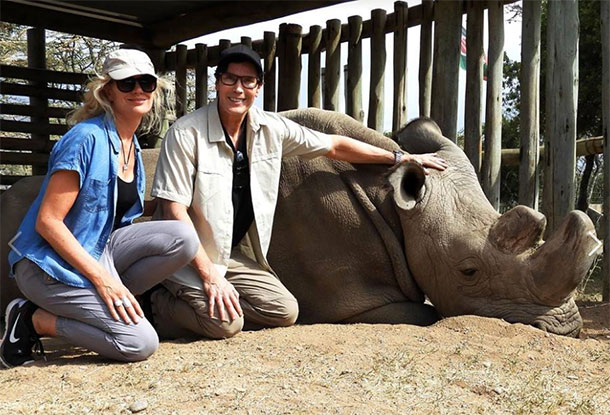
Animal conservation artists Gillian and Marc Schattner pose with Sudan, the last male Northern White Rhino at the Ol Pejeta conservancy in Kenya. (Photo: Gillieandmartcart, Wikimedia Commons, CC BY-SA 4.0)
BASCOMB: Up next – Using genetics to keep track of the highly endangered rhino, but first, this note on emerging science from Don Lyman.
LYMAN: The northern white rhinoceros is teetering on the verge of extinction. The last male died in March, and only two females remain, both in captivity in Kenya.
But there are 20,000 southern white rhinos, a closely related subspecies of the northern white rhino. And for the first time, scientists have injected preserved sperm from a northern white rhino into the eggs of female southern white rhinos – to create rhinoceros embryos in a lab.
Researchers from the Safari Park Dvůr Králové in the Czech Republic incubated embryos until the cells began to differentiate, which is the stage at which they could be implanted into a surrogate mother rhino. The researchers hope to eventually implant similar embryos into female southern white rhinos.
The researchers say even though any baby rhinos born using this technique would be a cross between northern and southern subspecies, it would be a way to preserve northern white rhino genes. Those genes could at some point allow scientists to recreate pure northern white rhinos through selective breeding. It’s an expensive process, and critics say that money could be better spent on conservation for endangered rhinos left in the wild.
Selective breeding for the northern white rhino would take several generations of rhinos and many decades.
However, the scientists are also planning to harvest eggs from the two remaining female northern white rhinos and fertilize those eggs with preserved northern white rhino sperm, a process which could produce a pure bred northern white rhino calf within the next three years.
That’s this week’s note on emerging science. I’m Don Lyman.
Related links:
- Ol Pejeta Conservancy
- The Safari Park Dvůr Králové in the Czech Republic
BASCOMB: Coming up – Controversy over the way formula is marketed to new parents. Stay tuned to Living on Earth!
ANNOUNCER: Funding for Living on Earth comes from you our listeners and United Technologies, combining passion for science with engineering to create solutions designed for sustainability in aerospace, building industries, and food refrigeration. UTC companies such as Otis, Carrier, Pratt and Whitney, and UTC Aerospace systems are helping to move the world forward. You can learn more about United Technologies by tuning into the Race to Nine Billion podcast; listen at race to nine billion dot com. That’s race to nine billion dot com. This is PRI, Public Radio International.
[MUSIC: Jo Ann Smith, “Rhythm Of the Rain” on Autoharp Legacy, Disc 2, by John Claude Gummoe, Arts In the Woods Recordings]
DNA Technology For Rhino Protection

A white rhino. (Photo: gmacfadyen, Flickr CC BY-NC-ND 2.0)
BASCOMB: It’s Living on Earth, I’m Bobby Bascomb. African rhinos are some of the most threatened animals on the planet. A rhinoceros is killed every day or so, as poachers go after their horns, which are more valuable than gold or platinum on the black market. But I found some hope for rhinos after visiting with researchers in South Africa.
[TRUCK DRIVING]
BASCOMB: Brittle yellow grass gently blows in the wind at the black rhino game reserve near Pilanesburg National Park in South Africa. Mathew Soekoe is a field guide here. Driving a safari truck he scans the familiar landscape and points towards a nearby fence.
SOEKOE: We’ve had two rhinos poached on our concession this year. They’re both right behind us over here, where both rhinos – the poachings took place. The one was successful, they did get the horn, and the other one, we kind of distracted them a bit early, so they weren’t successful in getting the horn, but unfortunately killing the rhino.
BASCOMB: Stories like that are extremely common here. So common that South African law requires that a tissue sample must be collected any time a rhino is moved from one park to another or receives medical care. The sample is used to create a DNA profile for each animal that can be recorded and, in case the animal is ever poached, can be matched to confiscated rhino horn.
[SFX – FREEZER DOOR CLOSES AND A SAMPLE BAG IS OPENED]
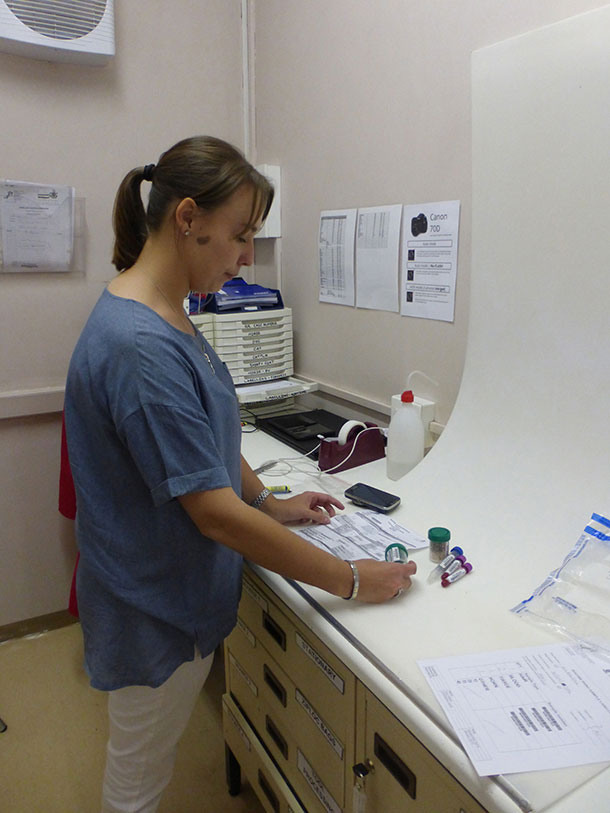
Amy Clark, a laboratory technician at the Veterinary Genetics Lab at the University of Pretoria. (Photo: Bobby Bascomb)
CLARK: What I’m going to be doing is I’m opening a routine kit from a live rhinoceros that has been collected in the field.
BASCOMB: Amy Clark is a laboratory technician at the Veterinary Genetics Lab at the University of Pretoria. She opens a plastic bag to examine small tubes holding rhino skin, hair, and blood. She pulls out a piece of paper with information about this specific rhino.
CLARK: We know from this particular animal that it is from a male white rhino. It is from the Limpopo province in South Africa. And this was from a live rhino.
[SFX – WALKING AND DOOR OPENS]
BASCOMB: Clark carries the samples down a hall to the sample preparation room where technicians pound rhino horn to a powder or cut off a small piece of tissue to examine. Then they add the samples to a solution and heat it.
CLARK: The heat causes the cells to break open and release the DNA. And from there we take that solution to a machine that uses magnetic beads to pull the DNA out of solution, so we can get a good quality DNA profile.
BASCOMB: The veterinary lab has a forensic analysis for roughly 18,000 rhinos. That’s nearly three quarters of the total population, and they hope to eventually register every rhino in the world. The rhino registry helps officials prosecute poaching crimes. Dr. Cindy Harper is the director of the lab. She says criminals in possession of illegal material like rhino horn might get a slap on the wrist, but when they’re linked back to a dead rhino – a crime scene – they’ll get a much harsher punishment.
HARPER: We’re looking at cases where poachers get 29 years and more because they are actually involved in an illegal hunt and not just possession of rhino horn.
BASCOMB: The sentence for poaching can vary greatly depending on the country where the poacher was caught. Rhino poaching is a well-organized, highly profitable crime, run by a heavily-armed international syndicate. Harper says her DNA database allows officers to keep tabs on how poachers are operating.
HARPER: If you look at internationally, that gives you some idea of the traceability of where that horn had moved from the carcass to its final destination and how quickly it moved.
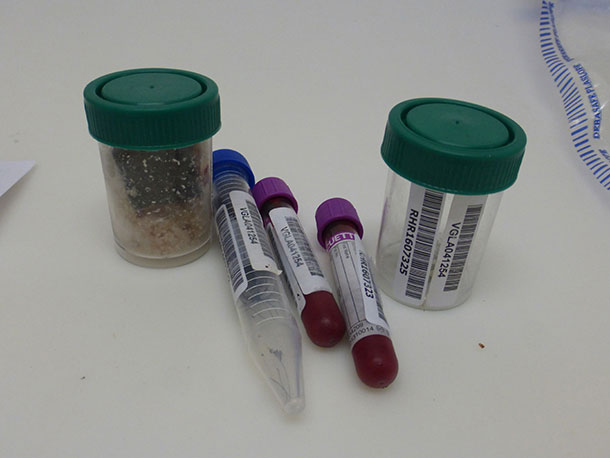
A rhino tissue sample kit. (Photo: Bobby Bascomb)
BASCOMB: It’s connecting the dots like that – between crime scene, transit, and consumer – that Jorge Rios says is so critical. Rios is the chief of the global program to combat wildlife and forest crime at the UN Office on Drugs and Crime. He says training prosecutors in the countries where rhino horns end up is the next step.
RIOS: You need to have a number of concurrent processes going. You need to do the forensics but, even if you have that information, you need to have the criminal legislation in place, and you need to have investigators and prosecutors who know how to use the scientific evidence. You need to train along the entire chain of enforcement.
BASCOMB: DNA technology is also being used to create synthetic rhino horn. A biotech company in Seattle, Washington makes synthetic horn, which they hope to sell at a lower price than real horn and put poachers out of business. But Cindy Harper from the DNA lab says the synthetic horn is virtually indistinguishable from the real horn, so she believes it’s a bad idea.
HARPER: The company that’s currently really at the top of the drive is wanting to put DNA into the actual synthetic horn, that is something I simply don’t understand. I don’t see any other synthetic product, such as synthetic fur or meat or anything else, having the actual animal’s DNA put into it. The only reason I can think for doing that is to try and make it impossible for law enforcement to differentiate that.
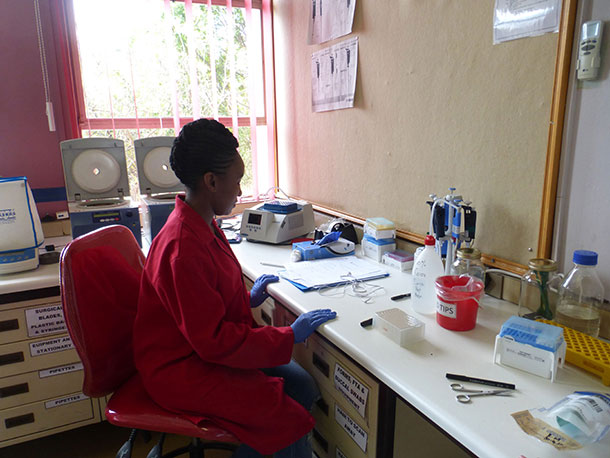
A lab tech processes a rhino DNA kit. (Photo: Bobby Bascomb)
BASCOMB: Harper says law enforcement agents already have their work cut out for them. She estimates that just one percent of seized rhino horn samples actually come back to her lab to get matched up on the database.
HARPER: That is the next step in the process. Making sure that we get these seized samples back and to be able to look at the whole movement of these horns globally. The criminals are organized. We need to make sure that everybody else who’s fighting those criminals are equally organized.
BASCOMB: Cindy Harper says what drives her is the race against time to save Africa’s rhinos. For each of the last several years more than a thousand have been killed by poachers annually.
Related links:
- Telegraph | "South Africa deploys CSI-style tactics to crack rhino poaching rings"
- University of Pretoria Veterinary Genetics Lab
[MUSIC: Maria Kalaniemi and Aldargaz, “Triolipolska” on Iho, by Timo Alakotila/arr. Timo Alakotila, Hannibal Music]
US Tries To Boost Infant Formula

A woman shops for infant formula at a convenience store in Singapore. The proposed regulations would not limit the availability of manufactured formulas, just the marketing towards them. (Photo: ProjectManhattan, Wikimedia Commons CC0 1.0 Public Domain)
BASCOMB: When it comes to feeding newborn babies the science is settled: when possible, breast is best. Breast milk has a myriad of health benefits that formula simply can’t rival. That became clear in the 1970s when Nestle began to aggressively market formula in developing countries and ran ads implying it was just as good as breast milk. Breast milk provides nursing babies with antibodies to protect from some infectious diseases like malaria. Denied that protection, as many as 1.5 million formula-fed babies died across the developing world. Alarm about Nestle’s advertising ultimately led to the International Code of Marketing Breast Milk Substitutes in 1981. A resolution to strengthen the code was expected to easily pass at a recent meeting of the World Health Assembly. But the US delegation shocked participants by opposing it. Here to explain is Elisabeth Sterken. She’s Director of the Infant Feeding Action Coalition in Canada.
Elisabeth, welcome to Living on Earth!
STERKEN: Thanks, Bobby. I'm really pleased to be here with you.
BASCOMB: So, how did you become interested in breastfeeding? What got you involved in this work to begin with?
STERKEN: Well, when I graduated as a nutritionist, one of the areas that I was really interested in was infant and young child nutrition. And at one point my husband got a Commonwealth scholarship to do a PhD in Nigeria, and so I came along. And I was hired by one of the universities in the pediatrics department, and my role was to set up a unit for malnourished children. And this is where I firsthand saw the devastation of formula feeding in a developing country where the water, of course, is just not potable for mixing formula and where the cost is prohibitive and where it's just very, you know, very deadly to be formula feeding – and where breast feeding is so normal. And to see the sabotaging of breast feeding in that context really hit home for me. And then to see the high mortality and the high rates of malnutrition and dehydration and other side effects that this would cause. As a matter of fact, we called it baby bottle syndrome.

A mother breastfeeds her infant. The World Health Organization guidelines suggest that babies be breastfed for two years or beyond. (Photo: Hugabub, Wikimedia Commons CC BY 2.0)
BASCOMB: Wow. So, recently the World Health Organization met in Geneva, Switzerland. Can you tell me what happened in Geneva?
STERKEN: So, this year Ecuador had taken the lead on a new resolution which included the new guidance on ending the inappropriate marketing of foods for infants and young children. However, when the Trump administration got wind of it, they began to threaten the Ecuador government with economic sanctions, and so Ecuador was forced to drop the lead on this proposed resolution. And subsequently the Russian Federation took up the lead and the other countries continued to support this particular resolution.
BASCOMB: So, you said that this was about trying to regulate inappropriate marketing of infant formula. What does that mean – inappropriate marketing – and what's an example of that?
STERKEN: Yes, for example, there's a lot of nutrition and health claims that are put in advertising, that are put on labels, to suggest that a certain ingredient that is put in the infant formula – such as DHA or ARA – will create better eyesight or create better brain development or better neurological development. So, the misleading advertising, the misleading statements, that are made about the formula rather then warnings about the fact that you've got increased diarrheal rates, you've got increased respiratory disease rates, you've got increased rates of obesity, cardiovascular disease, and various other long term consequences. So, formula feeding has not only the short-term consequences of infectious diseases, but also the long-term consequences for human health.
BASCOMB: So, what do you think was the US motivation for trying to water down the language promoting breast milk at the World Health Organization meeting?
STERKEN: Yes, well, we really have to see the marketing of breast milk substitutes as being in direct competition with mother's milk. The more formula you get into a baby's stomach, the bigger your profits, and if we look at the overall market of infant formula and baby foods, it's a $70 billion dollar market annually. So, the profits are huge. It's a huge incentive for these countries to see a weakened resolution.
BASCOMB: Well, shortly after this story came out, Trump took to Twitter and called this fake news. He said that, "The US strongly supports breastfeeding, but we don't believe that women should be denied access to formula. Many women need this option because of malnutrition and poverty." How do you respond to that?
STERKEN: Well, first of all, access is not a problem. The products will be available in pharmacies and supermarkets and shops globally. So, the International Code of Marketing of Breast Milk Substitutes does not restrict access, it restricts the marketing, the promotion of the products. And, of course, if you are living in poverty and you're suffering from malnutrition, it's an incredibly costly way to feed your infants. If the mother is malnourished, you want to support the mother nutritionally so that she can feed her baby. The Lancet estimates that roughly 820,000 lives will be saved when breast feeding becomes optimal. So, the death rate associated with artificial feeding – with formula feeding in the developing world – is disastrous. So, in areas of the world where malnutrition has a high prevalence and where poverty has a high prevalence, it becomes a deadly product.
BASCOMB: Well, to be clear, though, there are plenty of women around the world who simply can't breastfeed. They can't produce enough milk or they adopt a baby, and in those cases formula can be really vital for the baby's health.

Breastfeeding regulations brought forward at this spring’s World Health Assembly meeting would limit the misleading marketing of infant formulas put out by manufacturers such as Nestle. (Photo: SMM Chapman, own work, Wikimedia Commons CC-BY-SA 3.0)
STERKEN: Yes, yes, of course. Formula is not a product that should not be out there. Formula should be a product that is used when needed, and then all the precautions that are needed in order to prepare and feed the products safely should be there, as well as good health monitoring of infants who are formula-fed. So, those conditions should be in place for mothers who are unable to breast feed or if a mother has passed away and the baby needs to be fed with formula. So, there are those situations where there is a need for formula.
BASCOMB: Well, let's back up a bit. Why does the World Health Organization say breast feeding is the best option for babies?
STERKEN: For many reasons, of course. First of all we know that IQ levels are higher, there are less neurological problems, there are far fewer deaths related to diarrheal disease and upper respiratory disease, and then, of course, the long-term outcomes of cancers, diabetes, obesity, cardiovascular disease, the non-communicable diseases. They also are much lower in a breastfed population. And of course, breastfeeding is part of our normal reproductive system that creates this very special relationship between a mother and her infant and young child, and of course, these are things that you could never reproduce and put into a tin can.
BASCOMB: This is obviously a very personal and sensitive topic for parents, but what do you see in the future for the infant formula industry and breastfeeding in general?
STERKEN: Well, we're really hoping, of course, that countries will become more assertive about implementing the barriers that prevent the aggressive and deceptive marketing in their particular countries, and really support mothers to make decisions to breast feed their children. To attack breast feeding is attacking mother’s milk and that is sacred, that is part of our reproductive means, and it's part of our – it’s part of how we survive.
BASCOMB: Elisabeth Sterken is Director of the Infant Feeding Action Coalition in Canada. Thanks so much for taking the time to talk with me.
STERKEN: Thanks so very much. I really appreciate it.
BASCOMB: A statement from Nestle says in part: “we strive continuously to improve our practices and we have revised and reinforced our policy on breast milk substitutes a number of times.”
Related links:
- The New York Times | “Opposition to Breast-Feeding Resolution by U.S. Stuns World Health Officials”
- The New York Times | “Breast-Feeding or Formula? For Americans, It’s Complicated”
- POLITICO | “Trump attacks NYT over breastfeeding story”
- INFACT Canada
[MUSIC: Maria Kalaniemi and Aldargaz, “Sade” on Iho, by Timo Alakotila/arr. Timo Alakotila, Hannibal Music]
BASCOMB: Living on Earth is produced by the World Media Foundation. Our crew includes Naomi Arenberg, Thurston Briscoe, Savannah Christiansen, Jenni Doering, Anna Gibbs, Jaime Kaiser, Don Lyman, Maggie O’Brien, Aynsley O’Neill, Sarah Rappaport, Adelaide Chen, and Jolanda Omari.
Jake Rego engineered our show, with help from Mike Difilippo.
Alison Lirish Dean composed our themes.
You can hear us anytime at L-O-E dot org – and like us, please, on our Facebook page – PRI’s Living on Earth. And we tweet from @livingonearth.
The Executive Producer of our show, Steve Curwood, will be back next week. I’m Bobby Bascomb.
Thanks for listening!
ANNOUNCER: Funding for Living on Earth comes from you our listeners and from the University of Massachusetts, Boston in association with its School for the Environment, developing the next generation of environmental leaders. And from the Grantham Foundation for the Protection of the Environment, supporting strategic communications and collaboration in solving the world’s most pressing environmental problems. Support also comes from the Energy Foundation, serving the public interest by helping to build a strong clean energy economy.
ANNOUNCER 2: PRI, Public Radio International.
Living on Earth wants to hear from you!
Living on Earth
62 Calef Highway, Suite 212
Lee, NH 03861
Telephone: 617-287-4121
E-mail: comments@loe.org
Newsletter [Click here]
Donate to Living on Earth!
Living on Earth is an independent media program and relies entirely on contributions from listeners and institutions supporting public service. Please donate now to preserve an independent environmental voice.
NewsletterLiving on Earth offers a weekly delivery of the show's rundown to your mailbox. Sign up for our newsletter today!
 Sailors For The Sea: Be the change you want to sea.
Sailors For The Sea: Be the change you want to sea.
 The Grantham Foundation for the Protection of the Environment: Committed to protecting and improving the health of the global environment.
The Grantham Foundation for the Protection of the Environment: Committed to protecting and improving the health of the global environment.
 Contribute to Living on Earth and receive, as our gift to you, an archival print of one of Mark Seth Lender's extraordinary wildlife photographs. Follow the link to see Mark's current collection of photographs.
Contribute to Living on Earth and receive, as our gift to you, an archival print of one of Mark Seth Lender's extraordinary wildlife photographs. Follow the link to see Mark's current collection of photographs.
 Buy a signed copy of Mark Seth Lender's book Smeagull the Seagull & support Living on Earth
Buy a signed copy of Mark Seth Lender's book Smeagull the Seagull & support Living on Earth

